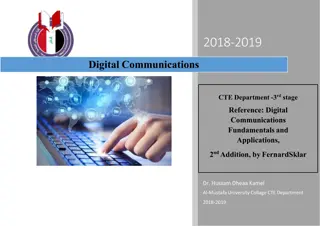Understanding Digital Communications in CTE Department: Concepts and Applications
In the realm of Digital Communications at the CTE Department, delve into a thorough exploration of fundamental principles and practical applications. Concepts such as television signal transmission, binary PCM, quantization levels, code word lengths, transmission bandwidth, signaling rates, and noise ratios are elucidated through examples and solutions. Discover the intricacies of PCM systems, signal-to-noise ratios, required transmission bandwidths, and code word lengths for analog signals. Sharpen your knowledge of digital communications within the academic context of the CTE Department.
Download Presentation

Please find below an Image/Link to download the presentation.
The content on the website is provided AS IS for your information and personal use only. It may not be sold, licensed, or shared on other websites without obtaining consent from the author. Download presentation by click this link. If you encounter any issues during the download, it is possible that the publisher has removed the file from their server.
E N D
Presentation Transcript
. : 2018-2019 Digital Communications CTE Department -3rdstage Reference: Digital Communications Fundamentalsand Applications, 2nd Addition, byFernardSklar Dr. Hussam Dheaa Kamel Al-Mustafa University Collage CTE Department 2018-2019
CTE Department -3rdstage Digital Communications Example 1: A television signal with bandwidth of 4.2 MHz is transmitted using binary PCM. The number of quantizatin levels is 512. Calculate: i. Code word length ii.Transmission bandwidth iii- Final bit rate iv- Output signal to quantization noise ratio Solution: i- ? = 2? 512 = 2? ???512 = ? ???2 = 9 ???? Thus the code word length is 9 bits ii- ?? ?? ?? 9 4.2 106 ?? 37.8 ??? 2
CTE Department -3rdstage Digital Communications iii- The signaling rate ? = ? ??= ? 2? = 9 2 4.2 106 ? = 75.6???? 1 Also we have ?? 2? ?? ?? 0.5 75.6 = 37.8 ??? which is same value obtained earlier (?) ?? = (4.8 + 6?)?? = 4.8 + 6 9 = 58.8 ?? iv- ? Example 2: The bandwidth of signal input to the PCM is restricted to 4 kHz. The input varies from -3.8V to +3.8 V and has the average power of 30 mW. The required signal to noise ratio is 20 dB. i. ii. Calculate the number of bits required per sample. Outputs of 20 such PCM coder are time multiplexed. What is the mimum required transmission bandwidth for the multiplexed signal? What is the signaling rate for the multiplexed signal? iii- Solution: ? ? ? (?) ?? =10???10 ( ) ?? =20?? ?=100 ? 3
CTE Department -3rdstage Digital Communications 22? 100 =3 30 10 3 22? ?= ? 3? i- (?2 (3.8)2 ) ??? 22?= 1444 = 24066.67 0.06 2????2 = log(24066.67) ? 7???? ii- ?? ?? and for 20 multiplexed signals ?? 20 7 4 ??? 840 ??? iii- The signalingrate ? = 2??= 2 840 = 1680 ???? 4
CTE Department -3rdstage Digital Communications Example 3: The information in an analog signal voltage waveform is to be transmitted over a PCM system with an accuracy of 0.1% (full scale). The analog signal has a bandwidth of 100Hz and an amplitude range of -10 to +10 volts. Determine: i- The number of levels required for such accuracy. ii- The code word length. iii. The minimum bit rate required. iv. The bandwidth required for PCM signal. Solution: i- The maximum quantization error should be 0.1%, so: ????= 0.001 ? But ????=|2| ? |2| = 0.001 ? ? ???? ???? ? = 0.002 5
CTE Department -3rdstage Digital Communications ? = 2????, ??? |????| = 10????? We have ? 2 10 Then 0.002 = ? = 10000 ? So that the number of levels are 10000. ii- We have ? = 2? 10000 = 2? ???10000 = ? ???2 ? ? ???? ???? ????? ? = 13.288 14 ???? iii- We have the bit rat ? = ???= ? 2 ? = 14 2 100 = 2800 ??? 1 The bandwidth required ?? 2 ? 2 2800 = 1400 ?? 1 iv- 6
CTE Department -3rdstage Digital Communications H.W: Q1/ The information in an analog waveform with maximum frequency ??= 3 ??? is to be transmitted over 16- levels PCM system. The quantization distortion is specified not exceed 1% of peak to peak analog signal. What is the number of bits per sample that should be used in this PCM? i- What is minimum bit transmission rate? ii- Q2 / A signal of bandwidth 3.5 kHz is sampled, quantized and coded by PCM system. The code signal is then transmitted over a transmission channel of supporting a transmission rate of 50 kbps. Calculate the maximum signal to noise that can obtained by this system. The input signal has peak to peak value of 4 volts and rms value of 0.2 V. Q3 / Consider an audio signal comprised of the sinusoidal term ?(?) = 3 cos(500??). i- Find the number of quantization level with an accuracy of 1%. ii- Determine the signaling rate. iii- The bandwidth of transmission channel. 7
CTE Department -3rdstage Digital Communications 4 Advantages of PCM: i. ii.PCM permits regeneration of pulses along the transmission path. This reduces noise interference. iii- Effect of channel noise and interference is reduced. The bandwidth and signal to noise ratio are related by exponentiallaw. iv. Multiplexing of various PCM signals is easily possible. v. Encryption or decryption can easily incorporated for securitypurpose. 5 Limitation of PCM: i. PCM system are complex compared to analog pulse modulation method. ii. The channel bandwidth is also increased because of digital coding of analog pulses. 6 Modifications of PCM: i. PCM can be modified to delta modulation. It is more simplified method of implementation. ii. The PCM can be used in wideband communications channels to overcome the bandwidth problem. iii. With the help of data comparison along with PCM, the redundancy can be removed and data rate can be reduced. 8























